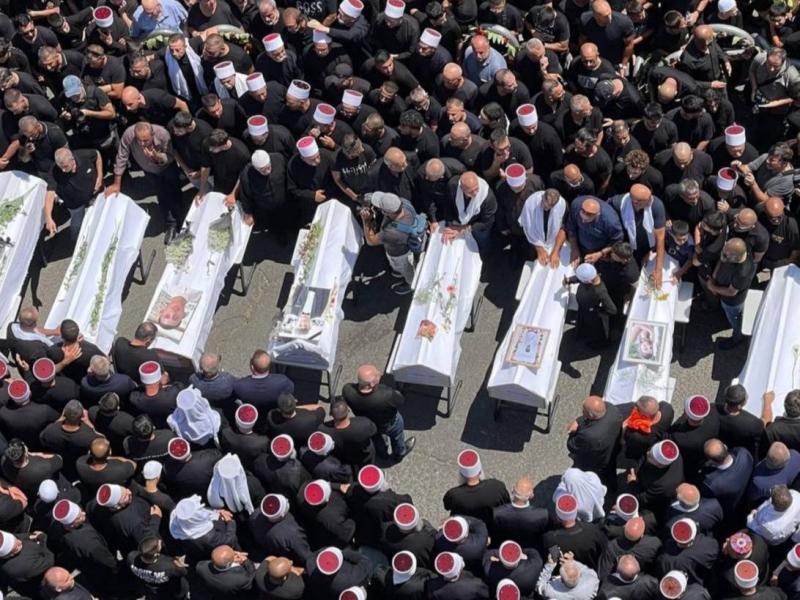Following the death of 12 people and the injury of more than 30 others due to a rocket falling on a football field in the Druze village of Majdal Shams in the occupied Golan Heights, with Israel blaming "Hezbollah" for the attack and the latter denying responsibility, how many Druze are there in the occupied Golan? Where are they concentrated? According to the "Times of Israel," among the 21,000 Druze residing in four towns in the Golan, about 4,300 are considered Israeli citizens, including some who inherited their "legal status" from parents who previously accepted citizenship.
The Druze refer to themselves as "the Monotheists," meaning believers in the oneness of God, and they are called "the sons of Ma'ruf." The name Druze is said to originate from Nashtakin al-Druzi, who broke away from the faith and fled to Lebanon to propagate his beliefs there. The Druze believe that God is one and is the eternal ruler of the universe. They consider Him exalted and beyond human descriptions, as human intellect is inadequate to comprehend the greatness of God's attributes. This sect is believed to have split from Ismailism during the Fatimid period in the tenth century, although some researchers consider it an independent doctrine.
### Demographics and Historical Context
The Druze are largely present in Lebanon, Syria, Israel, Jordan, and scattered areas elsewhere. Their history in Syria dates back around a thousand years, with a significant role in the region over time. They fought the Crusaders in the Battle of Hattin in 1187 and gained the trust of the Ayyubids and Zengids, who enhanced their presence in the area and entrusted them with many leadership roles. They continued to battle alongside the Mamluks against the Mongols in the Battle of Ain Jalut and later supported the Ottomans against Muhammad Ali's campaign in the Levant, inflicting significant losses on the Egyptians in Jabal al-Arab, south of Damascus, under the leadership of Sheikh Yahya al-Hamdan, who governed the mountain at that time.
The Druze later revolted against the Ottoman Empire, which repeatedly attempted to control the mountain. In 1911, the Ottomans executed mountain leaders after solidifying their control, with Zukhayyan al-Atrash and Yahya Amer being prominent among them. The Druze then declared allegiance to Sharif Hussein, and hundreds joined the Arab army, with leader Sultan Pasha al-Atrash being at the forefront of those raising the Arab flag in the mountain and later in Damascus. In 1925, the Druze played a key role in resisting the French occupation of Syria, refusing to form a Druze state and igniting the flames of the Great Syrian Revolution. Sultan Pasha al-Atrash led the Great Revolution against the French, who seized control of Syria in 1921. The Druze population in Syria is approximately 700,000, concentrated in the cities of Sweida, Salhiyah, Shahba, Qrayah in Jabal al-Arab, Jaramana near Damascus, and Majdal Shams in the occupied Golan. Notable Syrian Druze figures alongside Sultan Pasha al-Atrash include artist Farid al-Atrash, his sister singer Asmahan, and Fahd Bal'an.
### Lebanon
There have been no official statistics on the number of Druze in Lebanon since 1932, but unofficial sources estimate their number between 350,000 and 400,000, residing in 136 villages in Hasbaya, Rashaya, Shouf, Aley, Marjayoun, and Beirut. They constitute the majority in the cities of Aley, Bi'kline, Hasbaya, and Rashaya. The Druze political leaders have played a prominent role in Lebanese politics in recent decades, notably through Kamal Jumblatt, his son Walid Jumblatt, and Prince Majid Arslan. The affairs of the Druze community in Lebanon are managed by the "Spiritual Council," a very ancient institution that was not official until 1962.
### Israel
The number of Druze in Palestine was not small, and they faced persecution during the Ottoman rule due to their affiliation with the "Greater Lebanon" state attempted by Prince Fakhr ad-Din al-Ma'ani. At the establishment of the State of Israel, some chose to remain while others returned to Lebanon and Syria. Some sources indicate that the Druze entered into an agreement with Israel in 1948, gaining privileges in exchange for conscription into the Israeli army. The Druze have special courts specific to their independent sect concerning personal status, and their culture is Arabic, including their language. According to the Israeli Ministry of Foreign Affairs, the estimated number of Druze in Israel is about 104,000, including 18,000 in the Golan Heights occupied by Israel since 1967, equivalent to 1.6% of Israel's population. Most Druze reside in the Galilee and Mount Carmel and maintain continuous contact with their communities in Syria and Lebanon.
### Religious Hierarchy
The Druze have a class of religious leaders known as "the scholars," and their head is called the Sheikh of the Mind. In marriage, they prefer to marry within their community, which is built on mutual acceptance and consent between the parties. Rights and equality are preserved for both sides, and polygamy is prohibited among them, as marriage is based on clarity and transparency. Both parties must disclose their health, mental, and spiritual conditions, and the right to divorce is not exclusively held by men; women can initiate divorce if they wish.




